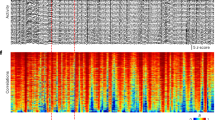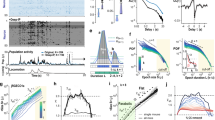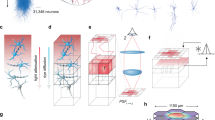Abstract
The cerebral cortex receives input from lower brain regions, and its function is traditionally considered to be processing that input through successive stages to reach an appropriate output1,2. However, the cortical circuit contains many interconnections, including those feeding back from higher centres3,4,5,6, and is continuously active even in the absence of sensory inputs7,8,9. Such spontaneous firing has a structure that reflects the coordinated activity of specific groups of neurons10,11,12. Moreover, the membrane potential of cortical neurons fluctuates spontaneously between a resting (DOWN) and a depolarized (UP) state11,13,14,15,16, which may also be coordinated. The elevated firing rate in the UP state follows sensory stimulation16 and provides a substrate for persistent activity, a network state that might mediate working memory17,18,19,20,21. Using two-photon calcium imaging, we reconstructed the dynamics of spontaneous activity of up to 1,400 neurons in slices of mouse visual cortex. Here we report the occurrence of synchronized UP state transitions (‘cortical flashes’) that occur in spatially organized ensembles involving small numbers of neurons. Because of their stereotyped spatiotemporal dynamics, we conclude that network UP states are circuit attractors—emergent features of feedback neural networks22 that could implement memory states or solutions to computational problems.
This is a preview of subscription content, access via your institution
Access options
Subscribe to this journal
Receive 51 print issues and online access
$199.00 per year
only $3.90 per issue
Buy this article
- Purchase on Springer Link
- Instant access to full article PDF
Prices may be subject to local taxes which are calculated during checkout




Similar content being viewed by others
References
Mountcastle, V. B. Perceptual Neuroscience: The Cerebral Cortex (Harvard Univ. Press, Cambridge, Massachusetts, 1998)
Hubel, D. H. & Wiesel, T. N. Functional architecture of the macaque monkey visual cortex. Proc. R. Soc. Lond. B 198, 1–59 (1977)
Lorente de Nó, R. Analysis of the activity of the chains of internuncial neurons. J. Neurophysiol. 1, 207–244 (1938)
Gilbert, C. & Wiesel, T. N. Morphology and intracortical projections of functionally characterised neurons in the cat visual cortex. Nature 280, 120–125 (1979)
Douglas, R. J. & Martin, K. A. C. in The Synaptic Organization of the Brain (ed. Shepherd, G. M.) 459–511 (Oxford Univ. Press, Oxford, 1998)
Somogyi, P., Tamas, G., Lujan, R. & Buhl, E. Salient features of synaptic organisation in the cerebral cortex. Brain Res. Brain Res. Rev. 26, 113–135 (1998)
Llinás, R. I of the Vortex: From Neurons to Self (MIT Press, Cambridge, Massachusetts, 2002)
Creutzfeldt, O. Cortex Cerebri (Oxford Univ. Press, Oxford, 1995)
Steriade, M., Contreras, D., Curro, D. R. & Nunez, A. The slow (< 1 Hz) oscillation in reticular thalamic and thalamocortical neurons: scenario of sleep rhythm generation in interacting thalamic and neocortical networks. J. Neurosci. 13, 3284–3299 (1993)
Tsodyks, M., Kenet, T., Grinvald, A. & Arieli, A. Linking spontaneous activity of single cortical neurons and the underlying functional architecture. Science 286, 1943–1946 (1999)
Sanchez-Vives, M. & McCormick, D. Cellular and network mechanisms of rhythmic recurrent activity in neocortex. Nature Neurosci. 3, 1027–1034 (2000)
Mao, B. Q., Hamzei-Sichani, F., Aronov, D., Froemke, R. C. & Yuste, R. Dynamics of spontaneous activity in neocortical slices. Neuron 32, 883–898 (2001)
Wilson, C. J. & Groves, P. M. Spontaneous firing patterns of identified spiny neurons in the rat neostriatum. Brain Res. 220, 67–80 (1981)
Cowan, R. L. & Wilson, C. J. Spontaneous firing patterns and axonal projections of single corticostriatal neurons in the rat medial agranular cortex. J. Neurophysiol. 71, 17–32 (1994)
Steriade, M., Nuñez, A. & Amzica, F. A novel slow (∼ 1 Hz) oscillation of neocortical neurons in vivo: depolarizing and hyperpolarizing components. J. Neurosci. 13, 3252–3265 (1993)
Anderson, J., Lampl, I., Reichova, I., Carandini, M. & Ferster, D. Stimulus dependence of two-state fluctuations of membrane potential in cat visual cortex. Nature Neurosci. 3, 617–621 (2000)
Fuster, J. M. The prefrontal cortex and its relation to behavior. Prog. Brain Res. 87, 201–211 (1991)
Goldman-Rakic, P. S. Cellular basis of working memory. Neuron 14, 477–485 (1995)
Durstewitz, D., Seamans, J. K. & Sejnowski, T. J. Neurocomputational models of working memory. Nature Neurosci. 3 suppl., 1184–1191 (2000)
Wang, X. J. Synaptic reverberation underlying mnemonic persistent activity. Trends Neurosci. 24, 455–463 (2001)
Seung, H. S., Lee, D. D., Reis, B. Y. & Tank, D. W. Stability of the memory of eye position in a recurrent network of conductance-based model neurons. Neuron 26, 259–271 (2000)
Hopfield, J. J. Neural networks and physical systems with emergent collective computational abilities. Proc. Natl Acad. Sci. USA 79, 2554–2558 (1982)
Badea, T., Goldberg, J., Mao, B. Q. & Yuste, R. Calcium imaging of epileptiform events with single-cell resolution. J. Neurobiol. 48, 215–227 (2001)
Shu, Y., Hasenstaub, A. & McCormick, D. A. Turning on and off recurrent balanced cortical activity. Nature 423, 288–293 (2003)
Constantinidis, C., Franowicz, M. & Goldman-Rakic, P. Coding specificity in cortical microcircuits: a multiple-electrode analysis of primate prefrontal cortex. J. Neurosci. 21, 3646–3655 (2001)
Ben-Yishai, R., Lev Bar-Or, R. & Sompolinsky, H. Orientation tuning by recurrent neural networks in visual cortex. Proc. Natl Acad. Sci. USA 92, 3844–3848 (1995)
Hebb, D. O. The Organization of Behaviour (Wiley, New York, 1949)
Majewska, A., Yiu, G. & Yuste, R. A custom-made two-photon microscope and deconvolution system. Pflugers Arch. 441, 398–409 (2000)
Acknowledgements
We thank D. McCormick for advice as well as J. Hopfield and members of our laboratory for comments. Supported by NEI, NINDS, FRM, the Human Frontier Science Program, the New York STAR Center for High Resolution Imaging of Functional Neural Circuits and the John Merck Fund.
Author information
Authors and Affiliations
Corresponding author
Ethics declarations
Competing interests
The authors declare that they have no competing financial interests.
Supplementary information
Rights and permissions
About this article
Cite this article
Cossart, R., Aronov, D. & Yuste, R. Attractor dynamics of network UP states in the neocortex. Nature 423, 283–288 (2003). https://doi.org/10.1038/nature01614
Received:
Accepted:
Issue Date:
DOI: https://doi.org/10.1038/nature01614
This article is cited by
-
The effects of different acetylcholinesterase inhibitors on EEG patterns in patients with Alzheimer’s disease: A systematic review
Neurological Sciences (2024)
-
Attractor and integrator networks in the brain
Nature Reviews Neuroscience (2022)
-
Two-photon calcium imaging of neuronal activity
Nature Reviews Methods Primers (2022)
-
NeuroPath2Path: Classification and elastic morphing between neuronal arbors using path-wise similarity
Neuroinformatics (2020)
-
Detecting neural assemblies in calcium imaging data
BMC Biology (2018)
Comments
By submitting a comment you agree to abide by our Terms and Community Guidelines. If you find something abusive or that does not comply with our terms or guidelines please flag it as inappropriate.



